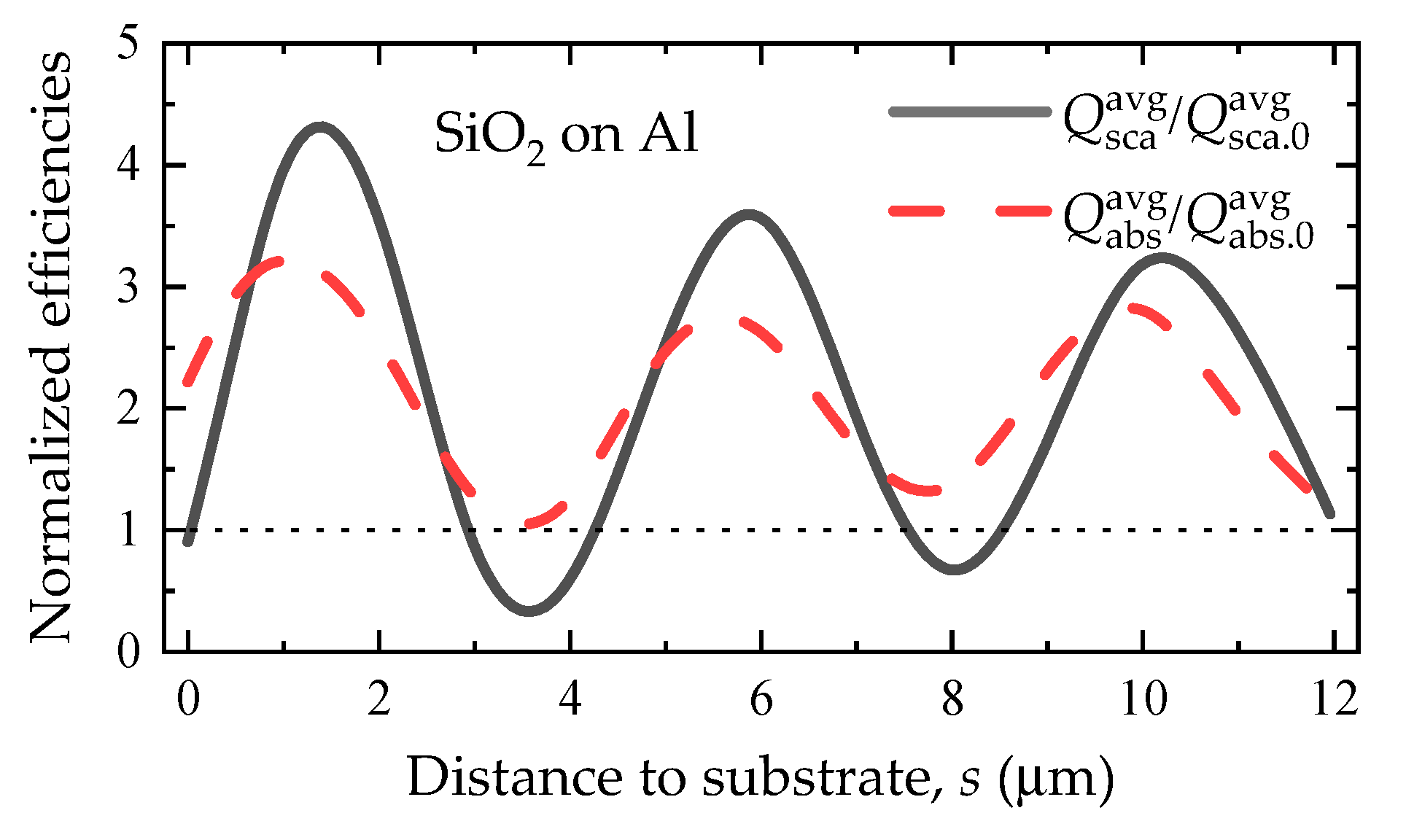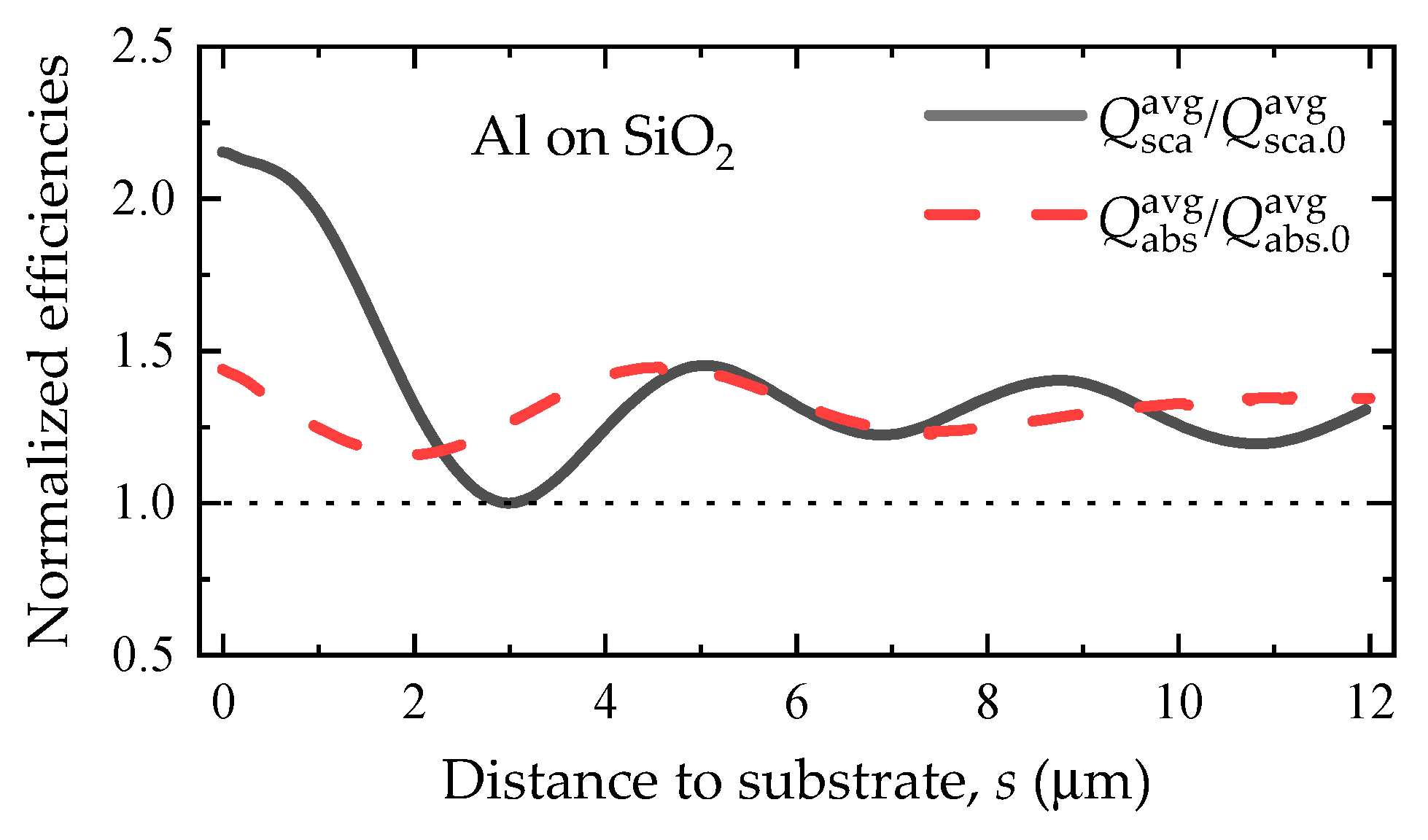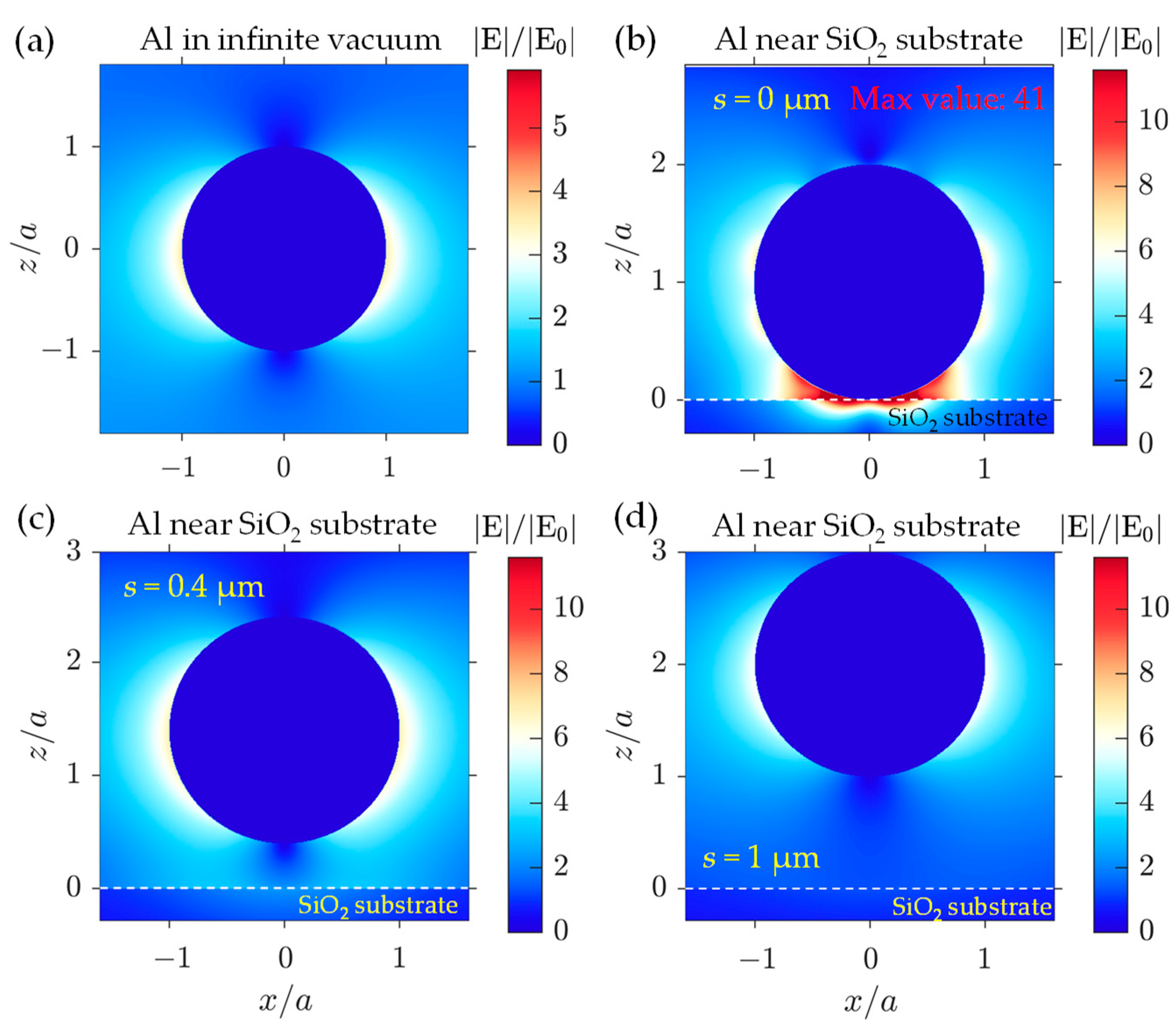Significant Substrate Effects on Electromagnetic Scattering by Particles in the Infrared Atmospheric Window
Abstract
1. Introduction
2. Materials and Methods
3. Results and Discussions
3.1. Case 1: Single SiO2 Sphere above Al Substrate
- The local fields-induced absorption enhancement could be traced from the electric field distribution near the particle;
- The local fields-induced absorption enhancement should vanish while the local fields enhancements disappear gradually with the moderately increasing distance.
3.2. Case 2: Single Al Sphere above SiO2 Substrate
4. Conclusions
Author Contributions
Funding
Institutional Review Board Statement
Informed Consent Statement
Data Availability Statement
Acknowledgments
Conflicts of Interest
References
- Bao, H.; Yan, C.; Wang, B.X.; Fang, X.; Zhao, C.Y.; Ruan, X.L. Double-layer nanoparticle-based coatings for efficient terrestrial radiative cooling. Sol. Energy Mater. Sol. Cells 2017, 168, 78–84. [Google Scholar] [CrossRef]
- Chen, M.J.; Pang, D.; Chen, X.Y.; Yan, H.J. Investigating the effective radiative cooling performance of random dielectric microsphere coatings. Int. J. Heat Mass Transf. 2021, 173, 121263. [Google Scholar] [CrossRef]
- Zhao, Y.W.; Pang, D.; Chen, M.J.; Chen, Z.; Yan, H.J. Scalable aqueous processing-based radiative cooling coatings for heat dissipation applications. Appl. Mater. Today 2022, 26, 101298. [Google Scholar] [CrossRef]
- Cheng, Z.M.; Han, H.; Wang, F.Q.; Yan, Y.Y.; Shi, X.H.; Liang, H.X.; Zhang, X.P.; Shuai, Y. Efficient radiative cooling coating with biomimetic human skin wrinkle structure. Nano Energy 2021, 89, 106377. [Google Scholar] [CrossRef]
- Wang, G.H.; Zhang, Y.; Zhang, D.H.; Fan, J.P. Design and calculation of low infrared transmittance and low emissivity coatings for heat radiative applications. Int. J. Miner. Metall. Mater. 2012, 19, 179–184. [Google Scholar] [CrossRef]
- Liang, J.; Li, W.; Xu, G.Y.; Meng, X.; Liu, K.; Tan, S.J. Preparation and characterization of the colored coating with low infrared emissivity based on nanometer pigment. Prog. Org. Coat. 2018, 115, 74–78. [Google Scholar] [CrossRef]
- Liu, Y.F.; Xie, J.L.; Luo, M.; Peng, B.; Xu, C.; Deng, L.J. The synthesis and optical properties of Al/MnO2 composite pigments by ball-milling for low infrared emissivity and low lightness. Prog. Org. Coat. 2017, 108, 30–35. [Google Scholar] [CrossRef]
- Liu, Z.H.; Ban, G.D.; Ye, S.T.; Liu, W.Y.; Liu, N.; Tao, R. Infrared emissivity properties of infrared stealth coatings prepared by water-based technologies. Opt. Mater. Express 2016, 6, 3716–3724. [Google Scholar] [CrossRef]
- Chen, S.; Yuan, L.; Weng, X.L.; Deng, L.J. Modeling emissivity of low-emissivity coating containing horizontally oriented metallic flake particles. Infrared Phys. Technol. 2014, 67, 377–381. [Google Scholar] [CrossRef]
- Dias, C.; Veloso, R.C.; Maia, J.; Ramos, N.M.M.; Ventura, J. Oversight of radiative properties of coatings pigmented with TiO2 nanoparticles. Energy Build. 2022, 271, 112296. [Google Scholar] [CrossRef]
- Zhai, Q.W.; Zhu, Q.Z. Radiative cooling film with self-cleaning function. Sol. Energy Mater. Sol. Cells 2021, 228, 111117. [Google Scholar] [CrossRef]
- Huang, Z.F.; Ruan, X.L. Nanoparticle embedded double-layer coating for daytime radiative cooling. Int. J. Heat Mass Transf. 2017, 104, 890–896. [Google Scholar] [CrossRef]
- Cheng, Z.M.; Shuai, Y.; Gong, D.Y.; Wang, F.Q.; Liang, H.X.; Li, G.Q. Optical properties and cooling performance analyses of single-layer radiative cooling coating with mixture of TiO2 particles and SiO2 particles. Sci. China Technol. Sci. 2021, 64, 1017–1029. [Google Scholar] [CrossRef]
- Mishra, B.R.; Sundaram, S.; Varghese, N.J.; Sasihithlu, K. Disordered metamaterial coating for daytime passive radiative cooling. AIP Adv. 2021, 11, 105218. [Google Scholar] [CrossRef]
- Song, K.L.; Xie, M.; Ai, Q.; Yang, L.; Liu, H.T.; Tan, H.P. Effects of size, volume fraction, and orientation of metallic flake particles on infrared radiation characteristics of Al/acrylic resin composite coatings. Prog. Org. Coat. 2020, 145, 105680. [Google Scholar] [CrossRef]
- Mishchenko, M.I.; Dlugach, J.M.; Yurkin, M.A.; Bi, L.; Cairns, B.; Liu, L.; Panetta, R.L.; Travis, L.D.; Yang, P.; Zakharova, N.T. First-principles modeling of electromagnetic scattering by discrete and discretely heterogeneous random media. Phys Rep. 2016, 632, 1–75. [Google Scholar] [CrossRef]
- Modest, M.F. Radiative Heat Transfer; Academic Press: Cambridge, MA, USA, 2013. [Google Scholar]
- Bohren, C.F.; Huffman, D.R. Absorption and Scattering of Light by Small Particles; Wiley: New York, NY, USA, 1983. [Google Scholar]
- He, Y.; Zhang, X.; Guan, J. Preparation and properties of EPDM-Based composite coatings with low infrared emissivity. J. Energy Eng. 2016, 142, 04016011. [Google Scholar] [CrossRef]
- Chou, K.S.; Lu, Y.C. The application of nanosized silver colloids in far infrared low-emissive coating. Thin Solid Film. 2007, 515, 7217–7221. [Google Scholar] [CrossRef]
- Fu, Y.; An, Y.D.; Xu, Y.K.; Dai, J.G.; Lei, D.Y. Polymer coating with gradient-dispersed dielectric nanoparticles for enhanced daytime radiative cooling. Ecomat 2022, 4, e12169. [Google Scholar] [CrossRef]
- Johnson, B.R. Light scattering from a spherical particle on a conducting plane. I: Normal incidence. J. Opt. Soc. Am. A 1992, 9, 1341–1351. [Google Scholar] [CrossRef]
- Johnson, B.R. Calculation of light scattering from a spherical particle on a surface by the multipole expansion method. J. Opt. Soc. Am. A 1995, 13, 326–337. [Google Scholar] [CrossRef]
- Lermé, J.; Bonnet, C.; Broyer, M.; Cottancin, E.; Manchon, D.; Pellarin, M. Optical properties of a particle above a dielectric interface: Cross sections, benchmark calculations, and analysis of the intrinsic substrate effects. J. Chem. Phys. 2013, 117, 6383–6398. [Google Scholar] [CrossRef]
- Videen, G. Light scattering from a sphere on or near a surface. J. Opt. Soc. Am. A 1991, 8, 483–489. [Google Scholar] [CrossRef]
- Mackowski, D.W. The extension of the multiple sphere T matrix code to include multiple plane boundaries and 2-D periodic systems. J. Quant. Spectrosc. Radiat. Transf. 2022, 290, 108292. [Google Scholar] [CrossRef]
- Ramezan pour, B.; Mackowski, D.W. Radiative transfer equation and direct simulation prediction of reflection and absorption by particle deposits. J. Quant. Spectrosc. Radiat. Transf. 2017, 189, 361–368. [Google Scholar] [CrossRef]
- Bobbert, P.A.; Vlieger, J. Light scattering by a sphere on a substrate. Phys. A Stat. Mech. Its Appl. 1986, 137, 209–242. [Google Scholar] [CrossRef]
- Miroshnichenko, A.E.; Evlyukhin, A.B.; Kivshar, Y.S.; Chichkov, B.N. Substrate-induced resonant magnetoelectric effects for dielectric nanoparticles. ACS Photonics 2015, 2, 1423–1428. [Google Scholar] [CrossRef]
- Evlyukhin, A.B.; Bozhevolnyi, S.I. Resonant unidirectional and elastic scattering of surface plasmon polaritons by high refractive index dielectric nanoparticles. Phys. Rev. B 2015, 92, 245419. [Google Scholar] [CrossRef]
- Loke, V.L.Y.; Menguc, M.P.; Nieminen, T.A. Discrete-dipole approximation with surface interaction: Computational toolbox for MATLAB. J. Quant. Spectrosc. Radiat. Transf. 2011, 112, 1711–1725. [Google Scholar] [CrossRef]
- Mizeikis, V.; Kowalska, E.; Ohtani, B.; Juodkazis, S. Frequency- and polarization-dependent optical response of asymmetric spheroidal silver nanoparticles on dielectric substrate. Phys. Status Solidi Rapid Res. Lett. 2010, 4, 268–270. [Google Scholar] [CrossRef]
- Markovich, D.L.; Ginzburg, P.; Samusev, A.K.; Belov, P.A.; Zayats, A.V. Magnetic dipole radiation tailored by substrates: Numerical investigation. Opt. Express 2014, 22, 10693–10702. [Google Scholar] [CrossRef] [PubMed]
- Sakurai, A.; Kawamata, T. Electromagnetic resonances of solar-selective absorbers with nanoparticle arrays embedded in a dielectric layer. J. Quant. Spectrosc. Radiat. Transf. 2016, 184, 353–359. [Google Scholar] [CrossRef]
- Hutter, T.; Elliott, S.R.; Mahajan, S. Interaction of metallic nanoparticles with dielectric substrates: Effect of optical constants. Nanotechnology 2013, 24, 035201. [Google Scholar] [CrossRef] [PubMed]
- Waxenegger, J.; Trügler, A.; Hohenester, U. Plasmonics simulations with the MNPBEM toolbox: Consideration of substrates and layer structures. Comput. Phys. Commun. 2015, 193, 138–150. [Google Scholar] [CrossRef]
- Hohenester, U.; Trügler, A. MNPBEM—A Matlab toolbox for the simulation of plasmonic nanoparticles. Comput. Phys. Commun. 2012, 183, 370–381. [Google Scholar] [CrossRef]
- Yamamoto, N.; Ohtani, S.; Garcia de Abajo, F.J. Gap and Mie plasmons in individual silver nanospheres near a silver surface. Nano Lett. 2011, 11, 91–95. [Google Scholar] [CrossRef]
- Pinchuk, A.; Hilger, A.; von Plessen, G.; Kreibig, U. Substrate effect on the optical response of silver nanoparticles. Nanotechnology 2004, 15, 1890–1896. [Google Scholar] [CrossRef]
- Knight, M.W.; Wu, Y.; Lassiter, J.B.; Nordlander, P.J.; Halas, N.J. Substrates matter: Influence of an adjacent dielectric on an individual plasmonic nanoparticle. Nano Lett. 2009, 9, 2188–2192. [Google Scholar] [CrossRef]
- Yang, C.; Liang, P.; Tang, L.S.; Zhou, Y.F.; Cao, Y.T.; Wu, Y.X.; Zhang, D.; Dong, Q.M.; Huang, J.; He, P. Synergistic effects of semiconductor substrate and noble metal nano-particles on SERS effect both theoretical and experimental aspects. Appl. Surf. Sci. 2018, 436, 367–372. [Google Scholar] [CrossRef]
- Liu, C.B.; Wang, C.X.; Chen, J.H.; Su, Y.J.; Qiao, L.J.; Zhou, J.; Bai, Y. Ultrasensitive frequency shifting of dielectric Mie resonance near metallic substrate. Research 2022, 2022, 9862974. [Google Scholar] [CrossRef]
- Yang, Y.; Miller, O.D.; Christensen, T.; Joannopoulos, J.D.; Soljacic, M. Low-Loss plasmonic dielectric nanoresonators. Nano Lett. 2017, 17, 3238–3245. [Google Scholar] [CrossRef] [PubMed]
- Sung, L.P.; Mulholland, G.W.; Germer, T.A. Polarized light-scattering measurements of dielectric spheres upon a silicon surface. Opt. Lett. 1999, 24, 866–868. [Google Scholar] [CrossRef] [PubMed]
- Rocco, D.; De Angelis, C.; de Ceglia, D.; Carletti, L.; Scalora, M.; Vincenti, M.A. Dielectric nanoantennas on epsilon-near-zero substrates: Impact of losses on second order nonlinear processes. Opt. Commun. 2020, 456, 124570. [Google Scholar] [CrossRef]
- Marino, G.; Gigli, C.; Rocco, D.; Lemaître, A.; Favero, I.; De Angelis, C.; Leo, G. Zero-Order Second Harmonic Generation from AlGaAs-on-Insulator Metasurfaces. ACS Photonics 2019, 6, 1226–1231. [Google Scholar] [CrossRef]
- Gili, V.F.; Carletti, L.; Chouchane, F.; Wang, G.; Ricolleau, C.; Rocco, D.; Lemaître, A.; Favero, I.; Ghirardini, L.; Finazzi, M.; et al. Role of the substrate in monolithic AlGaAs nonlinear nanoantennas. Nanophotonics 2018, 7, 517–521. [Google Scholar] [CrossRef]
- Gili, V.F.; Carletti, L.; Locatelli, A.; Rocco, D.; Finazzi, M.; Ghirardini, L.; Favero, I.; Gomez, C.; Lemaître, A.; Celebrano, M.; et al. Monolithic AlGaAs second-harmonic nanoantennas. Opt. Express 2016, 24, 15965–15971. [Google Scholar] [CrossRef]
- Abou-Hamdan, L.; Coudrat, L.; Bidault, S.; Krachmalnicoff, V.; Haïdar, R.; Bouchon, P.; De Wilde, Y. Transition from phononic to geometrical Mie modes measured in single subwavelength polar dielectric spheres. ACS Photonics 2022, 9, 2295–2303. [Google Scholar] [CrossRef]
- Qi, Z.Q.; Li, J.H.; Chen, P.; Zhang, L.L.; Ji, K. Tunable high-Q factor substrate for selectively enhanced raman scattering. Photonics 2022, 9, 755. [Google Scholar] [CrossRef]
- Li, X.X.; Jia, C.C.; Ma, B.J.; Wang, W.; Fang, Z.Y.; Zhang, G.Q.; Guo, X.F. Substrate-induced interfacial plasmonics for photovoltaic conversion. Sci. Rep. 2015, 5, 14497. [Google Scholar] [CrossRef]
- Li, G.C.; Zhang, Y.L.; Lei, D.Y. Hybrid plasmonic gap modes in metal film-coupled dimers and their physical origins revealed by polarization resolved dark field spectroscopy. Nanoscale 2016, 8, 7119–7126. [Google Scholar] [CrossRef]
- Jan, J.; Pavel, Z.; Alexandr, J.; Mojmir, S.; Pavel, P.; Miroslav, L. Behavior of nanoparticle and microparticle in the standing wave trap. In Proceedings of the 12th Czech-Slovak-Polish Optical Conference on Wave and Quantum Aspects of Contemporary Optics, Velke Losiny, Czech Republic, 12–15 September 2000; pp. 318–325. [Google Scholar]
- Cheng, Z.M.; Wang, F.Q.; Wang, H.; Liang, H.X.; Ma, L.X. Effect of embedded polydisperse glass microspheres on radiative cooling of a coating. Int. J. Therm. Sci. 2019, 140, 358–367. [Google Scholar] [CrossRef]
- Wang, H.D.; Xue, C.H.; Guo, X.J.; Liu, B.Y.; Ji, Z.Y.; Huang, M.C.; Jia, S.T. Superhydrophobic porous film for daytime radiative cooling. Appl. Mater. Today 2021, 24, 101100. [Google Scholar] [CrossRef]
- Cheng, Z.M.; Wang, F.Q.; Gong, D.Y.; Liang, H.X.; Shuai, Y. Low-cost radiative cooling blade coating with ultrahigh visible light transmittance and emission within an “atmospheric window”. Sol. Energy Mater. Sol. Cells 2020, 213, 110563. [Google Scholar]
- Mackowski, D.W. Multiple Sphere T Matrix Fortran-90 Code, Version 4.0. Available online: https://www.eng.auburn.edu/~dmckwski/scatcodes/ (accessed on 8 June 2022).
- Palik, E.D. Handbook of Optical Constants of Solids; Academic Press: Cambridge, MA, USA, 1998; Volume 1. [Google Scholar]
- Haynes, E.W.M. CRC Handbook of Chemistry and Physics; CRC Press: Boca Raton, FL, USA, 2016. [Google Scholar]
- Wang, T.; Li, P.; Hauer, B.; Chigrin, D.N.; Taubner, T. Optical properties of single infrared resonant circular microcavities for surface phonon polaritons. Nano Lett. 2013, 13, 5051–5055. [Google Scholar] [CrossRef] [PubMed]
- Wu, Z.Q.; Yang, J.L.; Manjunath, N.K.; Zhang, Y.J.; Feng, S.R.; Lu, Y.H.; Wu, J.H.; Zhao, W.W.; Qiu, C.Y.; Li, J.F.; et al. Gap-Mode surface-plasmon-enhanced photoluminescence and photoresponse of MoS2. Adv. Mater. 2018, 30, e1706527. [Google Scholar] [CrossRef]
- Xifre-Perez, E.; Shi, L.; Tuzer, U.; Fenollosa, R.; Ramiro-Manzano, F.; Quidant, R.; Meseguer, F. Mirror-image-induced magnetic modes. ACS Nano 2013, 7, 664–668. [Google Scholar] [CrossRef]
- Wriedt, T.; Doicu, A. Light scattering from a particle on or near a surface. Opt. Commun. 1998, 152, 376–384. [Google Scholar] [CrossRef]









Disclaimer/Publisher’s Note: The statements, opinions and data contained in all publications are solely those of the individual author(s) and contributor(s) and not of MDPI and/or the editor(s). MDPI and/or the editor(s) disclaim responsibility for any injury to people or property resulting from any ideas, methods, instructions or products referred to in the content. |
© 2023 by the authors. Licensee MDPI, Basel, Switzerland. This article is an open access article distributed under the terms and conditions of the Creative Commons Attribution (CC BY) license (https://creativecommons.org/licenses/by/4.0/).
Share and Cite
Gao, F.; Zhang, S.; Zhang, W.; Ma, L.; Liu, L. Significant Substrate Effects on Electromagnetic Scattering by Particles in the Infrared Atmospheric Window. Photonics 2023, 10, 476. https://doi.org/10.3390/photonics10040476
Gao F, Zhang S, Zhang W, Ma L, Liu L. Significant Substrate Effects on Electromagnetic Scattering by Particles in the Infrared Atmospheric Window. Photonics. 2023; 10(4):476. https://doi.org/10.3390/photonics10040476
Chicago/Turabian StyleGao, Feifei, Shangyu Zhang, Wenjie Zhang, Lanxin Ma, and Linhua Liu. 2023. "Significant Substrate Effects on Electromagnetic Scattering by Particles in the Infrared Atmospheric Window" Photonics 10, no. 4: 476. https://doi.org/10.3390/photonics10040476
APA StyleGao, F., Zhang, S., Zhang, W., Ma, L., & Liu, L. (2023). Significant Substrate Effects on Electromagnetic Scattering by Particles in the Infrared Atmospheric Window. Photonics, 10(4), 476. https://doi.org/10.3390/photonics10040476




